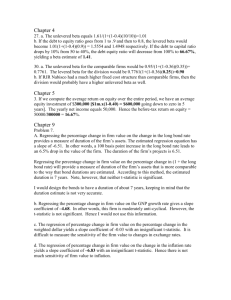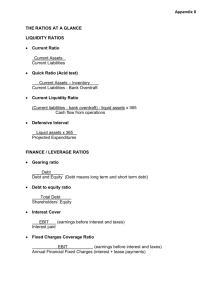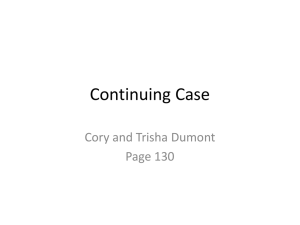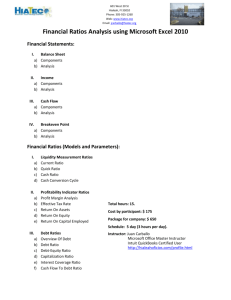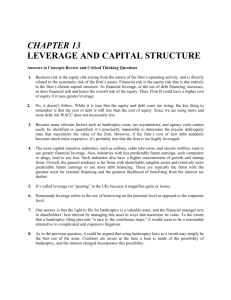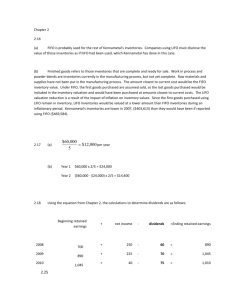Chapter 4: Analysis of Financial Statements
advertisement
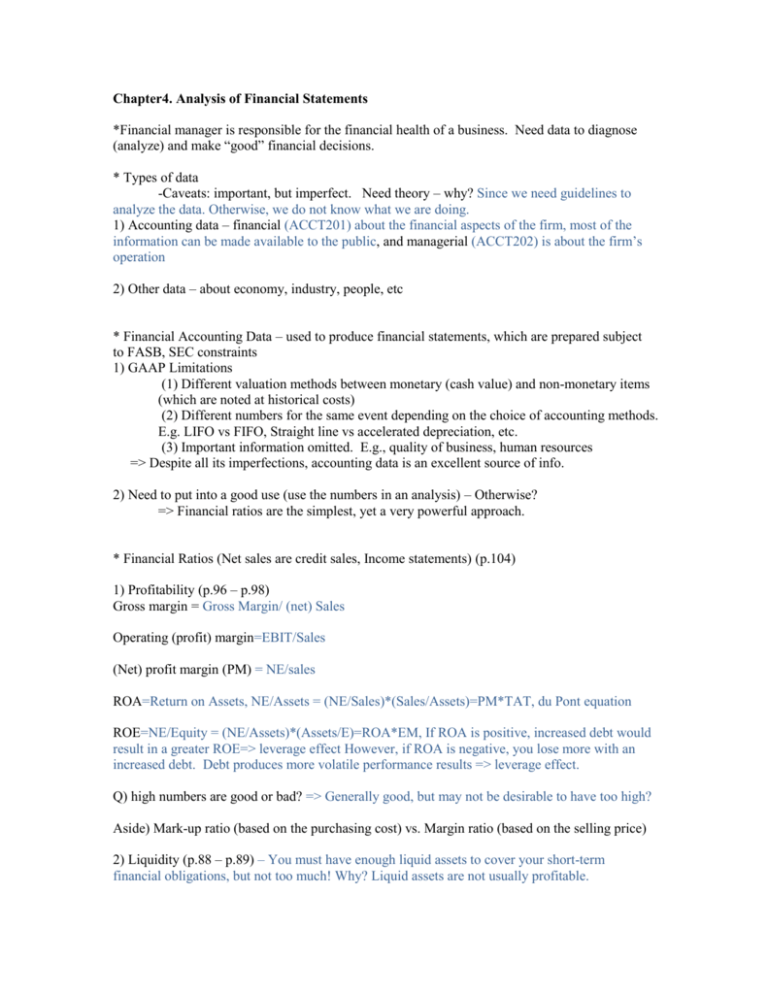
Chapter4. Analysis of Financial Statements *Financial manager is responsible for the financial health of a business. Need data to diagnose (analyze) and make “good” financial decisions. * Types of data -Caveats: important, but imperfect. Need theory – why? Since we need guidelines to analyze the data. Otherwise, we do not know what we are doing. 1) Accounting data – financial (ACCT201) about the financial aspects of the firm, most of the information can be made available to the public, and managerial (ACCT202) is about the firm’s operation 2) Other data – about economy, industry, people, etc * Financial Accounting Data – used to produce financial statements, which are prepared subject to FASB, SEC constraints 1) GAAP Limitations (1) Different valuation methods between monetary (cash value) and non-monetary items (which are noted at historical costs) (2) Different numbers for the same event depending on the choice of accounting methods. E.g. LIFO vs FIFO, Straight line vs accelerated depreciation, etc. (3) Important information omitted. E.g., quality of business, human resources => Despite all its imperfections, accounting data is an excellent source of info. 2) Need to put into a good use (use the numbers in an analysis) – Otherwise? => Financial ratios are the simplest, yet a very powerful approach. * Financial Ratios (Net sales are credit sales, Income statements) (p.104) 1) Profitability (p.96 – p.98) Gross margin = Gross Margin/ (net) Sales Operating (profit) margin=EBIT/Sales (Net) profit margin (PM) = NE/sales ROA=Return on Assets, NE/Assets = (NE/Sales)*(Sales/Assets)=PM*TAT, du Pont equation ROE=NE/Equity = (NE/Assets)*(Assets/E)=ROA*EM, If ROA is positive, increased debt would result in a greater ROE=> leverage effect However, if ROA is negative, you lose more with an increased debt. Debt produces more volatile performance results => leverage effect. Q) high numbers are good or bad? => Generally good, but may not be desirable to have too high? Aside) Mark-up ratio (based on the purchasing cost) vs. Margin ratio (based on the selling price) 2) Liquidity (p.88 – p.89) – You must have enough liquid assets to cover your short-term financial obligations, but not too much! Why? Liquid assets are not usually profitable. - Current ratio= CA/CL > 1 => CA is greater than CL, meaning that you have enough CAs to cover CLs=short-term debt. Quick ratio=(CA-Inventory)/CL, why? Since inventory is the least liquid current assets. Q) high or low? A number a little greater than 1.0 is good, but you do not want to have this number too high. Aside) factoring~ selling A/R 3) Effective Management (p.89 – p.92) (1) Working Capital Management=management of CAs and CLs Aside) most of B2B sales are credit sales -Accounts receivable turnover=Sales/(Average) A/R, a higher number indicates that you are managing your A/R effectively. However, you don’t want to have this number too high. Why? Because your A/R may be too tight and limiting your sales and the profits as a result. -Average collection period = (average) A/R / average daily sales Average daily sales = (Annual) Sales/365 or 360 = how many days to collect the A/R. You would want to have ACP shorter, but not too short. -Inventory turnover (may use sales instead of CGS) =Sales/Inventory, or CGS/Inventory, In general , you want to have a higher IT, but not too high Payable period Aside) Cash conversion cycle PO => Delivered, Invoice issued with a payment term (e.g., 30 days) usually around the delivery point, the products are stored as an inventory until they get sold => you have to wait until you will get paid. Typically, your payment term with your supplier is already up and you have already made the payment. CCC=> the time difference between the moment you pay and you will get paid = inventory period + receivable period – payment period Ex) inventory period=6 months, both payment period and receivable period = 30 days. CCC=6+1-1=6 months. If you have to borrow $10m, 8% annual => 10m*0.08/2=$400,000 (2) Fixed and Total Assets Fixed asset turnover = sales/(N)FA Aside NFA=Total Fixed Asset – Accumulated Depreciation TAT=Sales/TA, Aside) TA=CA+(N)FA 4) Debt: too much debt is not good, why? Vulnerable, maybe difficult to cover the liability=debt. However, if you are very certain about the success of your business, you may want to have “some” debt (manageable) to increase the size of business => make more money! Debt ratio = Debt/(Total)Assets Equity Multiplier=TA/E, Aside)Note that E=TA-L or Debt => increased debt=> smaller Equity TIE (p.92 – p.96) Times Interest Earned = EBIT/Interest Expenses : showing whether the business is making enough profits (EBIT) to cover interest expenses. If TIE<1 => they do not make enough money to be able to cover their interest payments. Increased debt=> increased interest expenses => the ratio, TIE gets smaller. So this ratio moves in the opposite directions of the other two ratios. 5) Dividend payout=Dividend/Net Earnings Retention ratio=Addition to Retained Earnings/Net Earnings = 1 – dividend payout ratio 6) Market Value: P/E, P/B, P/S - P/E=Stock Price (for one share)/EPS. EPS=Net Earnings/# of shares outstanding Ex) current stock price =$20, NE=$2m, # of shares outstanding=1m =>P/E=$20/$2=10. Aside) If the EPS is expected to be the same in the future, how long does it take to recover you $20 investment to buy the stock? 10 years is the payback period. If earnings are expected to grow in the future, then it would take less than 10 years to recover your $20 investment. Aside) (P/EPS) * EPS= Share Price, using this relationship, some people try to project true value=intrinsic value of a stock. Or try to estimate future stock price. Ex) Say, P/E=10 stays the same and the EPS is expected to be say, $2.50 => estimated price becomes $25. - P/B=Stock Price/BPS, BPS=Book Value/# shares outstanding - P/S=Stock Price/Sales per share Aside) P/E is a preferred choice. However, Net Earnings (and EPS) numbers change quite a bit and could be even negative. Therefore, we also use P/B and P/S ratios and there are more stable. * Du pont equations (p.101 – p.102) Remark: Optimal ratio numbers? How to compare numbers? (p.103, p.105) (1) Benchmark = try to change your ratios close to the benchmark numbers. (2) time-series=looking at the ratios of the same company over time to determine how things change. (3) cross-sectional = compare with other peer companies in the same industry or against industry averages. SIC (Standard Industry Code) can be used to determine different industries. * Other important issues for accounting data 1) Cash flows vs. accrual accounting data => Show me the money! vs. event (sale, etc) based records 2) Different types of costs Total costs, Average=Total costs/total # of units, Marginal=Incremental, extra cost for the last unit Sunk=costs already incurred=let bygones be bygones as we focus on the future, Opportunity cost (the best opportunity you may have to give up because of your choice)-example A=7% (9%), B=8% (9%), C=9%(8%) => Choose C since what you gain (9%) is greater than the opportunity cost of 8%. * Other Data (other than accounting data): 1) Economics data, 2) Data about people (stakeholders), 3) Process Data (quality of the product, efficiency) * EVA (P.108, p.290) = Economic Value Added, a measure of how much shareholders’ wealth is increased beyond what they can earn elsewhere. EVA=EBIT(1-T) – Total Investors’ Capital*After -Tax Cost of Capital p.108


